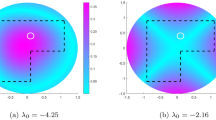Abstract
For the case of singularly perturbed elliptic transmission problems we demonstrate the use of asymptotic expansion techniques both for establishing regularity results for the solution and for deriving a priori error estimates for boundary element Galerkin discretisation. The dependence of the corresponding bounds on the singular perturbation parameter is studied in detail. This dependence clearly manifests itself in numerical experiments.







Similar content being viewed by others
Notes
Subscripts attached to constants hint at their dependence on parameters.
References
Bendali, A., Lemrabet, K.: Asymptotic analysis of the scattering of a time-harmonic electromagnetic wave by a perfectly conducting metal coated with a thin dielectric shell. Asymptot. Anal. 57(3), 199–227 (2008)
Braess, D.: Finite Elements: Theory, Fast Solvers, and Applications in Solid Mechanics, 3rd edn. Cambridge University Press, Cambridge (2007)
Buffa, A., Christiansen, S.: A dual finite element complex on the barycentric refinement. Math. Comp. 76(260), 1743–1769 (2007)
Concepts Development Team: Webpage of Numerical C++ Library Concepts 2 (2012). http://www.concepts.math.ethz.ch
Engquist, B., Nédélec, J.C.: Effective boundary conditions for acoustic and electromagnetic scattering in thin layers. Rapport interne du C.M.A.P, Ecole Polytechnique Paris (1993)
Frauenfelder, P., Lage, C.: Concepts: an object-oriented software package for partial differential equations. Math. Model. Numer. Anal. 36(5), 937–951 (2002)
Haddar, H., Joly, P., Nguyen, H.: Generalized impedance boundary conditions for scattering by strongly absorbing obstacles: the scalar case. Math. Models Methods Appl. Sci. 15(8), 1273–1300 (2005)
Haddar, H., Joly, P., Nguyen, H.M.: Generalized impedance boundary conditions for scattering problems from strongly absorbing obstacles: the case of Maxwell’s equations. Math. Models Methods Appl. Sci. 18(10), 1787–1827 (2008)
Hiptmair, R., Jerez-Hanckes, C.: Multiple traces boundary integral formulation for Helmholtz transmission problems. Adv. Appl. Math. 37(1), 39–91 (2012)
Hiptmair, R., Mao, S.P.: Stable multilevel splittings of boundary edge element spaces. BIT 52(3), 661–685 (2012)
McLean, W.: Strongly Elliptic Systems and Boundary Integral Equations. Cambridge University Press, Cambridge (2000)
Meury, P.: Stable Finite Element Boundary Element Galerkin Schemes for Acoustic and Electromagnetic Scattering. Ph.D. thesis, ETH Zurich, Zürich, Switzerland (2007)
Poignard, C.: Asymptotics for steady-state voltage potentials in a bidimensional highly contrasted medium with thin layer. Math. Meth. Appl. Sci. 31(4), 443–479 (2008)
Sauter, S., Schwab, C.: Boundary Element Methods. Springer, Heidelberg (2011)
Schmidt, K., Chernov, A.: Robust families of transmission conditions of high order for thin conducting sheets. Matheon report # 1044, Research Center Matheon, Berlin (2013). https://opus4.kobv.de/opus4-matheon/frontdoor/index/index/docId/1253
Schmidt, K., Chernov, A.: A unified analysis of transmission conditions for thin conducting sheets in the time-harmonic eddy current model. SIAM J. Appl. Math. 73(6), 1980–2003 (2013)
Schmidt, K., Chernov, A.: Robust transmission conditions of high order for thin conducting sheets in two dimensions. IEEE Trans. Magn. 50(2), 41–44 (2014)
Schmidt, K., Hiptmair, R.: Asymptotic boundary element methods for thin conducting sheets. Preprint 2013–2019, Seminar for Applied Mathematics, ETH Zürich (2013). https://www.sam.math.ethz.ch/sam_reports/reports_final/reports2013/2013-19.pdf
Schmidt, K., Hiptmair, R.: Asymptotic boundary element methods for thin conducting sheets. Discrete Contin. Dyn. Syst. Ser. 8(3), 619–647 (2015)
Schmidt, K., Tordeux, S.: High order transmission conditions for thin conductive sheets in magneto-quasistatics. ESAIM Math. Model. Numer. Anal. 45(6), 1115–1140 (2011)
Steinbach, O.: Numerische Näherungsverfahren für elliptische Randwertprobleme. Finite Elemente und Randelemente. B.G. Teubner-Verlag (2003)
Sterz, O., Schwab, C.: A scalar boundary integrodifferential equation for eddy current problems using an impedance boundary condition. Comput. Vis. Sci. 3(4), 209–217 (2001)
Yuferev, S., Ida, N.: Surface Impedance Boundary Conditions: A Comprehensive Approach. CRC Press, Boca Raton (2010)
Author information
Authors and Affiliations
Corresponding author
A Discrete dual projections
A Discrete dual projections
Given a triangulation \(\varGamma _{h}\) of \(\varGamma \) let \(S^{0}_{1}(\widehat{\varGamma }_{h})\) be a space of continuous piecewise linear functions on its barycentric refinement \(\widehat{\varGamma }_h\) for which nodal values at the barycentres of cells of \(\varGamma _{h}\) provide valid degrees of freedom. The construction of suitable \(S^{0}_{1}(\widehat{\varGamma }_{h})\) on a triangulated curve is described in [9, Sect. 4.4.1], and in [3, Sect. 2] for a triangulated surface. In each case simple local computations establish
with a constant depending only on the shape-regularity of \(\varGamma _{h}\). As an immediate consequence of (43) we have the dual inf-sup condition
Thus we can define two projectors \(Q_{h}:L^2({\varGamma })\rightarrow S^{-1}_{0}(\varGamma _{h})\) and \(Q_{h}^{*}:L^2({\varGamma })\rightarrow S^{0}_{1}(\widehat{\varGamma }_{h})\) through
Both, \(Q_{h}\) and \(Q_{h}^{*}\) will be \(L^2({\varGamma })\)-continuous with norms bounded by \(C_{\mathrm {ST}}^{-1}\). Moreover,
where \(C>0\) may also depend on the quasi-uniformity of \(\varGamma _{h}\). This estimate is a consequence of the continuity of the \(L^2({\varGamma })\)-orthogonal projection onto \(S^{0}_{1}(\widehat{\varGamma }_{h})\) in \(H^1({\varGamma })\). Then, interpolation between \(H^1({\varGamma })\) and \(L^2({\varGamma })\) immediately yields

Next, we appeal to the definition of the norm of  and get
and get

Thus we have established the following result.
Lemma 5
The projection \(Q_{h}\) defined in (45) can be extended to a bounded operator  .
.
We remark that with the same arguments, this result can also be established for the standard \(L^2({\varGamma })\)-orthogonal projection onto \(S^{0}_{1}(\varGamma _{h})\).
Rights and permissions
About this article
Cite this article
Schmidt, K., Hiptmair, R. Asymptotic expansion techniques for singularly perturbed boundary integral equations. Numer. Math. 137, 397–415 (2017). https://doi.org/10.1007/s00211-017-0881-y
Received:
Revised:
Published:
Issue Date:
DOI: https://doi.org/10.1007/s00211-017-0881-y



